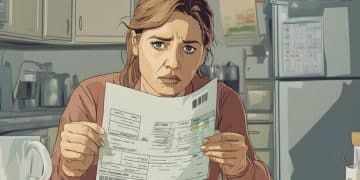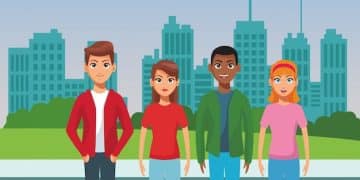The Latest Updates on Federal Student Loan Forgiveness Programs in 2025

The Latest Updates on Federal Student Loan Forgiveness Programs in 2025 include potential changes to existing programs, new eligibility requirements, and ongoing legal challenges that borrowers need to understand.
Stay informed about the latest updates on Federal Student Loan Forgiveness Programs in 2025 as these programs continue to evolve, offering potential relief to millions of borrowers but also facing significant adjustments and legal hurdles.
Understanding the Current Landscape of Student Loan Forgiveness
The landscape of student loan forgiveness is constantly changing. It’s crucial to understand the current state of affairs before diving into what 2025 might hold. This includes knowing about existing programs and their current status.
Existing Federal Student Loan Forgiveness Programs
Several federal student loan forgiveness programs are already in place, each with its own set of requirements and eligibility criteria. Understanding these programs is essential for borrowers seeking relief.
Income-Driven Repayment (IDR) Plans
IDR plans, such as Income-Based Repayment (IBR), Pay As You Earn (PAYE), and Saving on a Valuable Education (SAVE), offer forgiveness after a certain number of years of qualifying payments, typically 20 or 25 years.
- Understand the nuances of each IDR plan to determine which one best fits your financial situation.
- Keep detailed records of your payments and income to ensure accurate tracking for forgiveness.
- Stay informed about any changes to IDR plans, as these can impact your eligibility and forgiveness timeline.

Public Service Loan Forgiveness (PSLF)
PSLF forgives the remaining balance on Direct Loans after 120 qualifying payments made while working full-time for a qualifying employer, such as a government organization or a non-profit.
It’s important to note that the eligibility criteria and application processes for these programs can be complex and may change over time. Borrowers should regularly check for updates and seek professional guidance if needed.
In summary, the current landscape involves a mix of established initiatives facing continuous adjustments. Keeping abreast of these changes is vital for anyone depending on these programs to manage their student debt.
Potential Changes to Federal Student Loan Forgiveness Programs in 2025
Looking ahead to 2025, several potential changes could impact federal student loan forgiveness programs. These changes could affect eligibility, the amount of forgiveness offered, and the overall administration of the programs.
Legislative and Regulatory Updates
New legislation or regulatory changes could significantly alter the landscape of student loan forgiveness. Keep an eye on any proposed bills or policy changes that could impact your eligibility.
The Future of the SAVE Plan
The SAVE Plan is relatively new, its long-term sustainability and potential modifications are key areas to watch. Future adjustments could affect its benefits and accessibility.
- Monitor official announcements from the Department of Education regarding any potential changes to the SAVE Plan.
- Consult with financial advisors to understand how these changes might affect your personal financial planning.
- Stay informed about legal challenges to the SAVE Plan, as these could impact its implementation and future.
Borrowers should stay informed about these potential changes and be prepared to adapt their repayment strategies accordingly.

Impact of Economic Conditions
Economic factors such as inflation, unemployment rates, and overall economic growth can also influence student loan forgiveness programs. Economic downturns may lead to increased pressure for broader forgiveness measures, while economic growth could result in stricter eligibility requirements.
In conclusion, the future of student loan forgiveness programs remains uncertain. Staying informed and adaptable is crucial for borrowers navigating this evolving landscape.
Eligibility Requirements: Who Qualifies in 2025?
Understanding the eligibility requirements for federal student loan forgiveness programs is crucial for borrowers seeking relief. These requirements can vary depending on the specific program and may change over time.
Income Thresholds and Employment Criteria
Many forgiveness programs have income thresholds that borrowers must meet to qualify. Additionally, some programs require specific types of employment, such as public service.
Eligibility for various student loan forgiveness programs often hinges on meeting specific income thresholds and adhering to particular employment criteria. It’s essential to understand these requirements to determine eligibility.
- Verify the income thresholds for each program and ensure your income falls within the permissible range.
- Confirm that your employment qualifies for programs like PSLF, which requires working for eligible employers.
- Document your income and employment diligently to meet the verification requirements of these programs.
Loan Types and Consolidation
The type of loan you have can also affect your eligibility for forgiveness. Some programs only apply to Direct Loans, while others may include FFEL or Perkins Loans.
Navigating student loan forgiveness requires a clear understanding of how loan types and consolidation impact eligibility. Certain programs are exclusive to Direct Loans, making consolidation a crucial step for borrowers with other loan types.
Borrowers should carefully review the eligibility criteria for each program and consult with a financial advisor to determine the best course of action.
In sum, eligibility hinges on detailed analysis and strict adherence to program mandates. Proper planning can optimize your potential for receiving loan forgiveness benefits.
Navigating the Application Process for Loan Forgiveness
Applying for student loan forgiveness can be a complex process, requiring careful attention to detail and adherence to specific guidelines. Understanding the steps involved is essential for a successful application.
Required Documentation and Forms
Gathering all the necessary documentation is a critical first step in the application process. This may include income statements, employment verification, and loan documents.
Common Mistakes to Avoid
Many borrowers make common mistakes that can delay or even disqualify their application. Avoiding these pitfalls is essential for a smooth process. A frequent misstep is incomplete paperwork, which can cause significant delays.
- Double-check all forms for accuracy and completeness before submitting.
- Ensure that all required documentation is included with your application.
- Follow up regularly with the loan servicer to check on the status of your application.
Borrowers should take their time, be thorough, and seek assistance from reputable sources if needed to increase their chances of success.
Legal Challenges and Program Uncertainty
Federal student loan forgiveness programs have faced numerous legal challenges, leading to uncertainty about their future. Understanding these challenges is crucial for borrowers relying on these programs.
Supreme Court Rulings and Their Impact
Supreme Court rulings have played a significant role in shaping the landscape of student loan forgiveness. These rulings can impact the scope and legality of forgiveness programs. The Supreme Court’s decisions have broad implications for the legality and implementation of student loan forgiveness initiatives, affecting millions of borrowers.
Future Lawsuits and Potential Outcomes
Additional lawsuits could be filed challenging the legality of forgiveness programs. The outcomes of these lawsuits could further complicate the situation. Preparing for potential outcomes is essential in managing financial planning around student loans. Future legal battles could either expand or curtail these programs, creating significant uncertainty for borrowers.
- Stay informed about current legal challenges and potential future lawsuits.
- Understand how these legal challenges could impact the availability of forgiveness programs.
- Consult with legal experts to assess your options and protect your rights.
Given the ever-changing legal landscape, borrowers should stay informed and be prepared for potential changes to their repayment plans.
Strategies for Borrowers in 2025
With the uncertain future of federal student loan forgiveness programs, it’s essential for borrowers to develop proactive strategies for managing their debt in 2025. These strategies can help borrowers navigate the complexities of repayment and maximize their chances of achieving financial stability.
Exploring Alternative Repayment Options
Consider alternative repayment options such as income-driven repayment plans or loan consolidation to lower monthly payments. Income-Driven Repayment Plans (IDR) and loan consolidation offer flexible solutions to ease the burden of student loan debt.
Refinancing Options
For those with good credit, refinancing to a lower interest rate can save money over the life of the loan although refinancing federal loans into private loans forfeits federal protections and forgiveness programs.
- Assess your current financial situation and repayment goals.
- Research different repayment options and choose the one that best fits your needs.
- Consider the pros and cons of refinancing before making a decision.
By taking proactive steps to manage their debt, borrowers can mitigate the risks associated with program uncertainty and achieve long-term financial success.
| Key Point | Brief Description |
|---|---|
| 🔄 SAVE Plan | New income-driven plan affecting many borrowers. |
| 🏛️ Legal Challenges | Programs face legal challenges that could change their scope. |
| 📝 Eligibility | Requirements vary; check income, employment, and loan type. |
| 📊 Economic Impact | Economic conditions may lead to program adjustments. |
Frequently Asked Questions (FAQ)
▼
The SAVE Plan is a new income-driven repayment plan designed to make student loan payments more affordable based on income and family size, potentially leading to faster forgiveness for some borrowers.
▼
Legal challenges can alter the scope and availability of forgiveness programs, sometimes leading to delays or even the termination of certain initiatives depending on court rulings.
▼
PSLF generally requires 120 qualifying payments made while working full-time for a qualifying employer, such as a government organization or a non-profit, under a Direct Loan.
▼
Yes, consolidating loans can impact eligibility. Consolidating non-Direct Loans into a Direct Consolidation Loan is often required to qualify for certain forgiveness programs like PSLF.
▼
The official U.S. Department of Education website is the best source for the latest information, along with contacting your loan servicer directly for personalized advice based on your situation.
Conclusion
Staying informed about the latest updates on federal student loan forgiveness programs in 2025 is essential for borrowers navigating this complex landscape. By understanding the potential changes, eligibility requirements, and legal challenges, borrowers can develop proactive strategies to manage their debt and achieve financial stability. Consulting with financial advisors and legal experts can provide personalized guidance and support.





